| |
|
|
| |
Spring has sprung.
Tue 1st September, 2015
|
|
|
|
 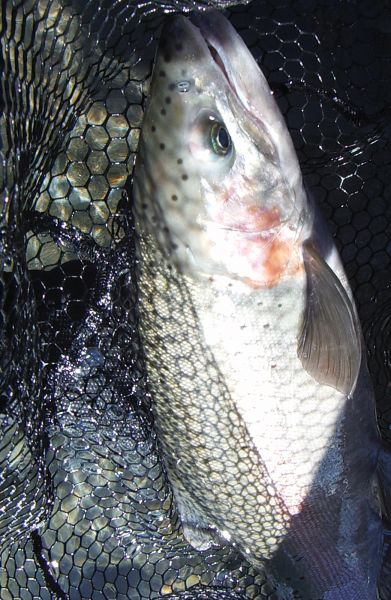 Its already a ouple of weeks since I posted a "proper" report and during that time Spring has sprung ... where does it go? Its already a ouple of weeks since I posted a "proper" report and during that time Spring has sprung ... where does it go?
Typical spring weather the last few days and we've experienced all four seasons depending when you fished. Cool misty mornings, warm sunny afternoons and by the looks of things its back to rain and heavy showers today with the wind picking up. In fact it looks as if its going to be unsettled again for most of this week.
It was another very busy weekend angler wise and a lot of the popular pools were occupied well before dawn. It hasn't been like this for a few years and its good to see that anglers think its worth dusting off the headlamps again.
Fish have been running most days and if you get on the water early it hasn't been difficult to get plenty of hook ups ... providing you get a few Tongariro winter basics right.
This advice is repeated on the web-sites every year. They'll all tell you if you want to hook up consistently, fish adequate weight, on a long enough leader to get those flies down and keep them down with confident mending.
Casting heavy bombs is not a pleasant experience for novice anglers. But you can ease the pain because this is winter fishing on the Tongariro ... so forget about nice tight loops and pretty casts.
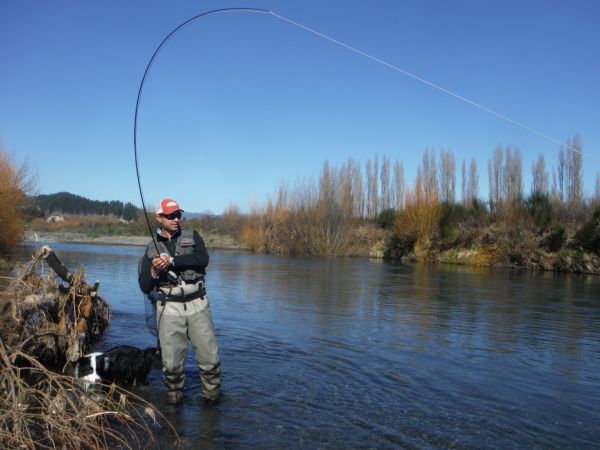
Learn to water load. That way you won't bombard the river in front of you with dozens of pointless false casts as you try in vain to delay the effects of gravity on a 5mm tungsten bead and a couple of split shot.
Providing you don't thrash the water you intend drifting your flies through I doubt the fish care less how you cast. But what they do care about is how their next potential meal behaves as it drifts towards them.
You must learn to mend effectively so that you delay the onset of of drag on the fly line and leader during the drift.
Learning to mend properly is probably more difficult than learning to cast. Put simply you're trying to counteract the effect the various surface currents have on your line as it floats downstream. So what ever the river tries to do with your line ... you do the opposite. There's a little more to it than that but this action of re-positioning the fly line on the surface is called "mending".
If your new to fly fishing this link may help ... or confuse you even more!
Click on Nymphing and scroll down the page until you come to "Controlling the drift".
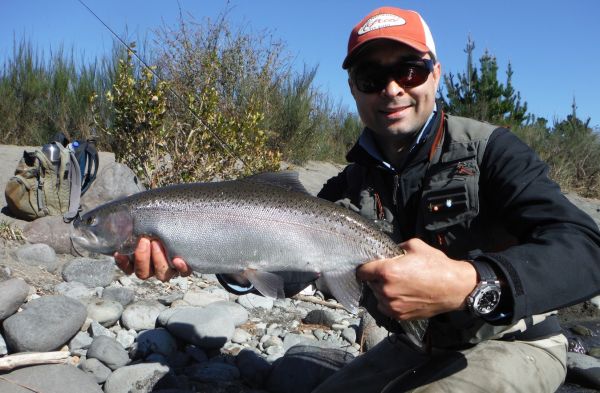 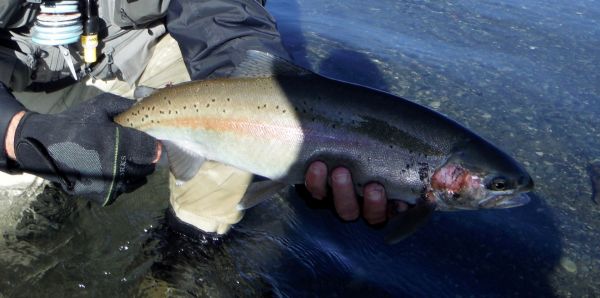 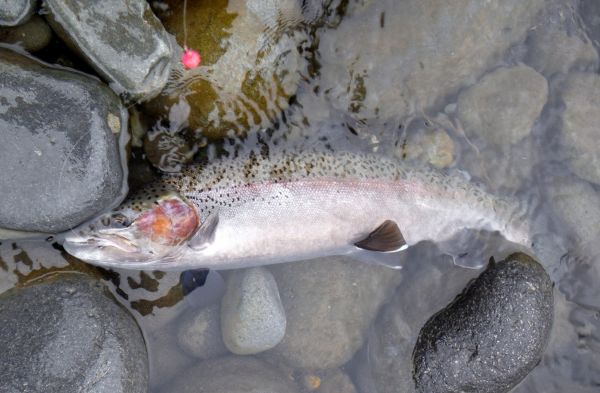
Sean was down for a few days and we had a great time covering as much water as possible from Reed to the Fence Pool. Despite meeting up each morning at 6.00 am we weren't always the first to arrive at our chosen spot but had no problems hooking up. When the Tongariro is firing like this it does wonders for your angling ego ... its a fantastic river.
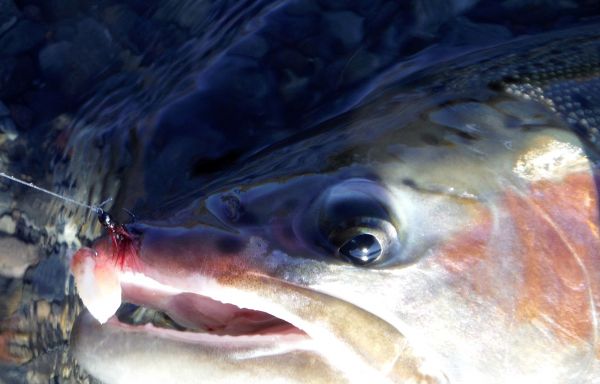
We caught where ever we fished. Most of the time using a globug/nymph combo on a three fly rig. Best fish landed ... a rainbow close on five pounds which Sean had in one of the upper river pools.
The "ones that got away" are always the best fish of the day and we had our fair share of those ... including a couple of browns.
But we weren't the only ones. This jack is one of a few I've had lately with my own nymph and someone else's globug in its mouth.
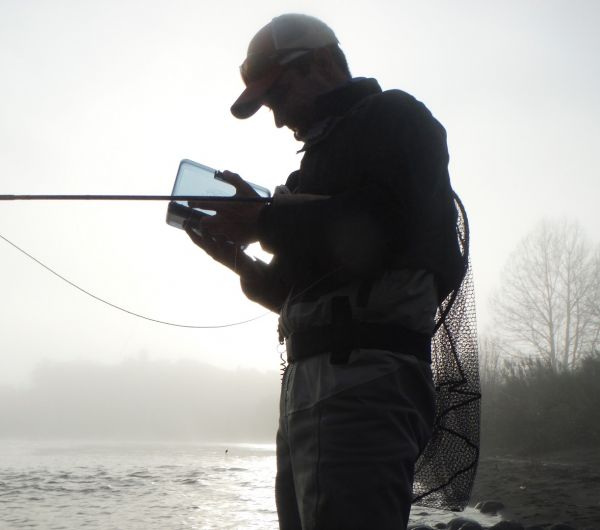
The 2015 winter runs have definitely been the year of the globug, making fly choice easy for beginners. But I keep saying there is more to the Tongariro than bombs and globugs. The majority of fish in the river are not resident trout. The only reason they're in the river is to spawn. They've spent the previous couple of years in the lake feeding mainly on smelt as they grow and mature. Once they enter the rivers their diet changes and they gradually adapt to the available food supply. For the novice angler this is the next big hurdle after they've mastered basic casting and mending ... which fly to use when nymphing. Fly choice is a massive subject but we'll try and keep it simple. First of all its important to understand what your trying to achieve during the nymphing drift. The flies you tie on the end are not {in this case} lures. In other words your not pulling or swinging the flies through the water in order to provoke a fish into striking them. You're attempting to imitate the natural insects that live amongst the rocks and stones of the riverbed. Most rivers will have populations of what we'll call the "big three"... caddis, mayfly and stonefly and trout will prey on the various stages of their life cycles. In New Zealand these are lumped under the heading "naturals". The numbers of these aquatic insects in all their forms vary at different times of the year {and day} depending on climatic conditions and natural phenomenon such as floods etc. The more abundant a particular insect is the more likely it is the trout will be feeding on them. On some rivers trout can be frustratingly picky when they tune into a specific food source ... the dreaded " match the hatch ". Luckily spawning rainbows are more obliging once they've switched on to the nymphs and larvae available to them. Usually if you're "somewhere near" this will do. So when you walk into the tackle shop and are confronted by dozens of trays, containing thousands of flies,which ones are you going to spend your hard earned dollars on to catch a trout in the Tongariro! New trout flies are invented somewhere in the world every day. Below are some trusty old favorites and a few modern patterns that should get you a fish or two on the river.
The Pheasant Tail Nymph
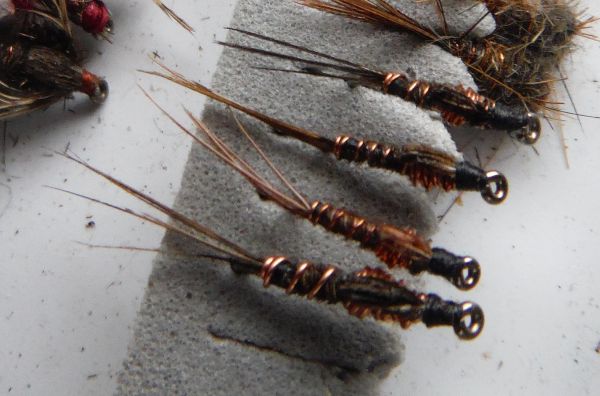 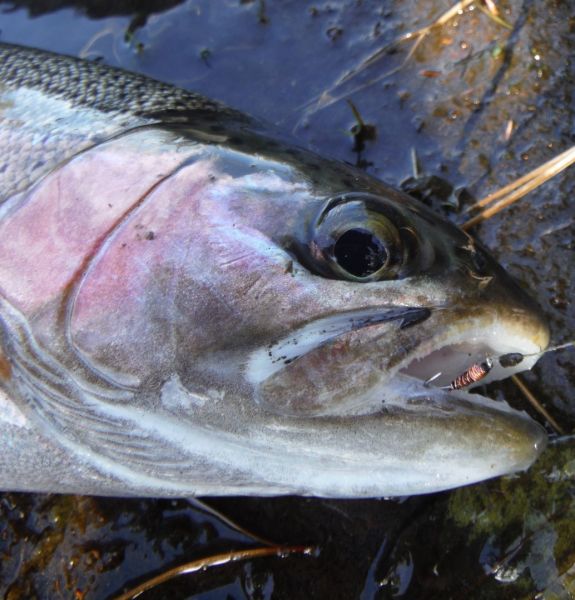
Originally devised and tied nearly sixty years ago by the legendary Frank Sawyer MBE. Frank was a river-keeper on Wiltshire's river Avon and an accomplished angler and author. He came up with the pattern to mimic various species of the Baetis family of mayfly commonly called "olives" that thrived in English chalk-streams. This simple but deadly nymph was constructed using pheasant tail fibers and thin copper wire from an old dynamo. The original tying of the fly was unusual because he didn't use thread. Instead he twisted the fibers and wire around one another and wound them forward to create the body and thorax of the fly. He'd noticed that when the nymphs were swimming their legs were folded back giving the nymph a slim profile so the original pattern was tied without legs. There are now hundreds of variations on the original fly but I doubt there are many fly fishers around who would leave these out of their box.
BH Czech Flash Back PT and BH PT Flash Back
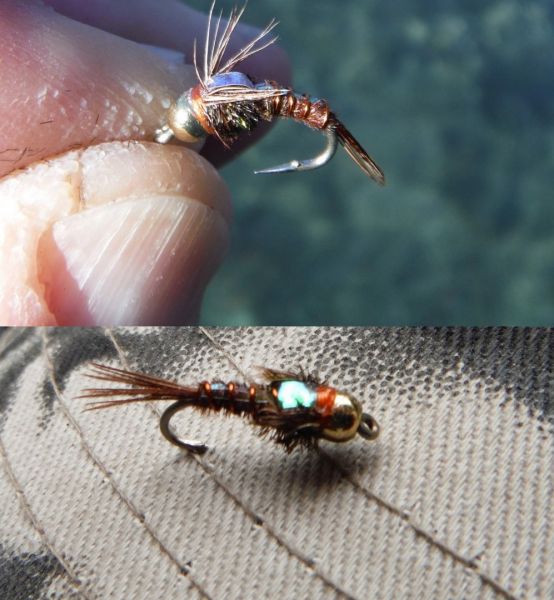
Manic Tackle produce a great range of premium flies that don't fall apart ... ok you can buy cheaper but as always you get what you pay for. These two variants on the Pheasant Tail theme are essentially the same fly tied on different hooks. I'm a fan of curved hooks I think they give the nymphs a realism because the curve suggests flexibility. This one works well under the big dry and the addition of a bead head means it gets down fast. The other tied on a straight hook I use as the middle fly on a three fly rig off the bomb. The combination of a bead and the flash back make it a perfect attractor pattern on the Tongariro that really gets the attention of spawning rainbows.
Globugs
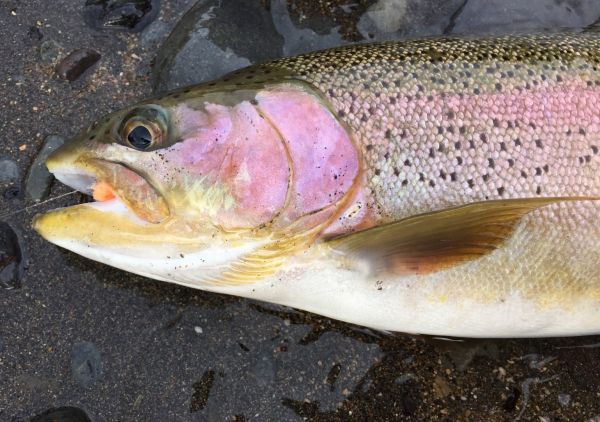 The most often used "fly" on the Tongariro and a "must have" during the runs. The most often used "fly" on the Tongariro and a "must have" during the runs.
This year in particular there have been days when the fish wouldn't look at anything else.
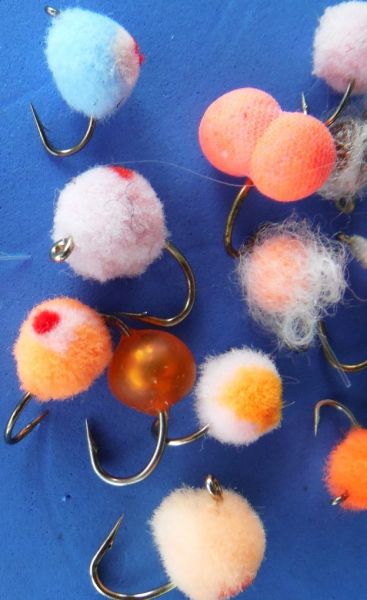 Most anglers put this down to the temporary decline in the numbers of natural insects in the river due to the series of floods we've experienced this year. Most anglers put this down to the temporary decline in the numbers of natural insects in the river due to the series of floods we've experienced this year.
Trout will often predate on fish eggs but when they first enter the river its probably the bright colors that trigger a strike.
Large globugs often work best then but as they continue to be pelted with the things on their upstream migration they become a little more wary of them. Thats the time to experiment with size, color and different types of egg-fly.
They come in endless colors and color combinations and are made from all kinds of materials ... globug yarn, foam, plastic or epoxy beads and even a realistic rubber like substance sometimes called a jelly egg.
A pattern a lot of anglers swear by this year is the jelly egg with some white foam yarn tied in sparingly over the top. It represents a freshly dropped egg covered in milt and in the States is called The Comb Over Egg. Come to think of it that's what they used to call me before I started shaving my head!
If your comfortable fishing three flies try two globugs of a different size and color below the bomb. Similarly a globug/nymph combo off the bomb can be very effective at this time of year.
Caddis
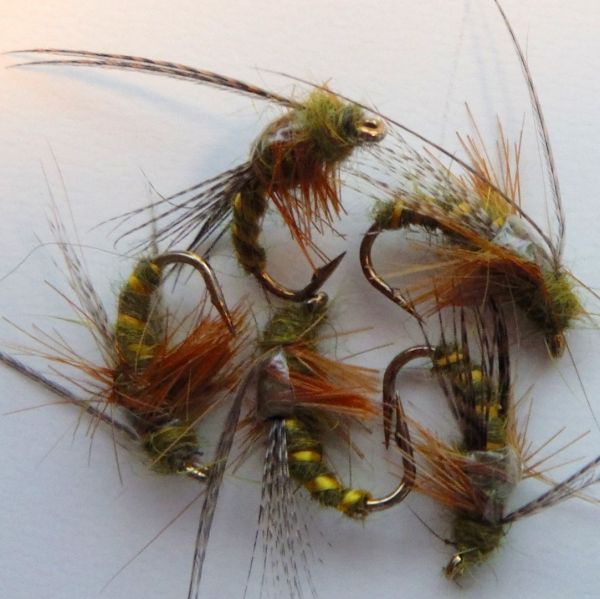 Caddis are one of the most important food sources for trout in rivers across the globe. Caddis are one of the most important food sources for trout in rivers across the globe.
The Tongariro is no exception but if an angler tells you he's using caddis he's normally referring to a fly that mimics a caddis larva. Want to try something a little different? Then tie on a caddis pupa.
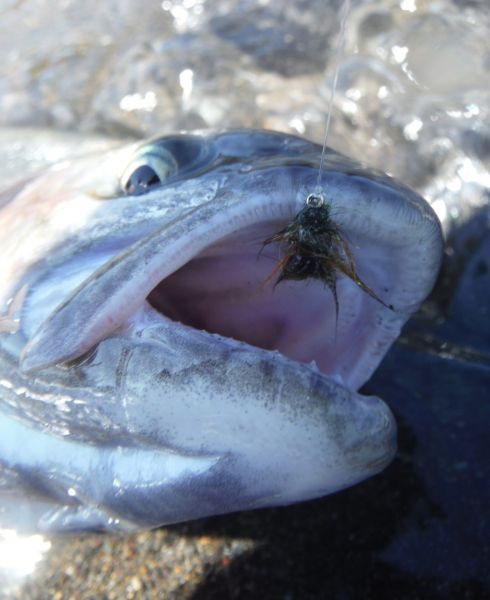
As the larva matures below the surface it forms a cocoon where it eventually changes into the pupa. Its final transition into the adult takes place in the surface film. But before the pupa is ready to ascend to the surface it generates a gas bubble to aid its upward journey.
People like Gary LaFontaine who studied the life cycle of caddis using scuba gear, observed pupa with this bubble drifting helplessly near the bottom until they began floating to the surface. Trout homed in on this behavior and eagerly picked off this easy food supply.
As a result he developed his Sparkle Pupa series of flies to imitate this. But try this one from Scottish fly tyer Davie McPhail. The image above is a simpler version I had tied up but here's a link to a tutorial on tying the more realistic original. McPhails Caddis Pupa
This works well off the bomb but tied with a bead head is a belter on a long dropper under the dry.
The Hares Ear/ Hare and Copper
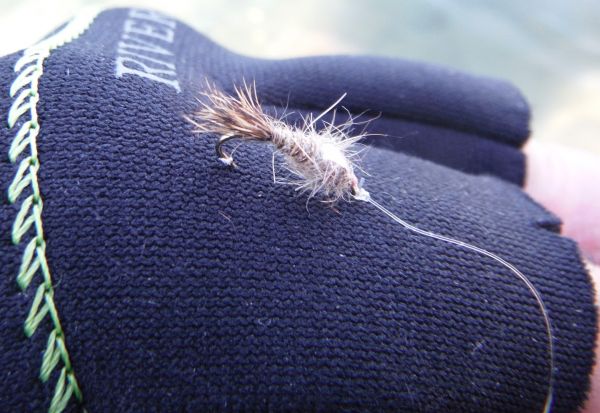
Similar flies ... the Hares Ear/Hare and Copper is a favorite pattern of New Zealand anglers and indeed fly fishers everywhere. One of the oldest fly patterns around no-one seems to know who first came up with it. Frequently labelled the "anything and everything" fly because its simple buggy appearance allows the trout to mistake it for a variety of aquatic nymphs. One of the easiest flies to learn to tie and often the first one beginners attempt. A great prospecting pattern if your not sure what the fish are feeding on. Make sure you have plenty of these in your box.
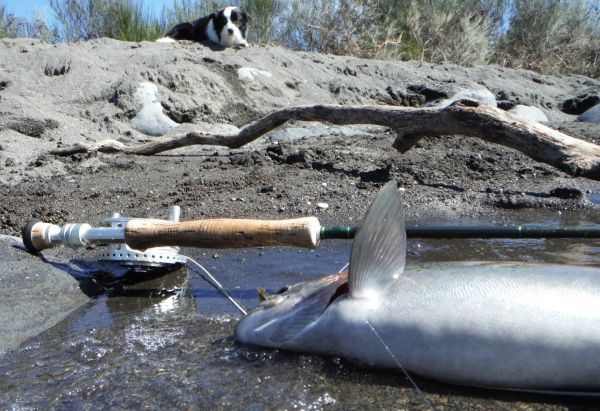
The Met Service was spot on again and it rained all day. Another mini-fresh saw the river peak earlier at just over 50 cumecs. Its dropping back again as I finish this and I'm expecting plenty of good fishing for the rest of the week.
Tight lines guys
Mike |
|
|
| Back to Top |
|
|
|
|
|
|
|